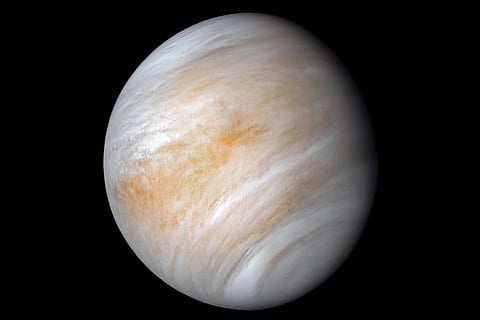

Chennai
And truth be told, the scientists who announced on Sept 14 the discovery of phosphine, a gas, in Venus’s atmosphere did not claim to have discovered life, either — only that they could not think of anything that might have produced it other than microbes in the clouds. “We’re not saying we discovered life on Venus,” Sara Seager of the MIT said in an interview a few days before the announcement.
On Earth, anyway, the only natural source of phosphine is microbes; the gas is often associated with faeces. But it would hardly rank as a surprise to find out that scientists don’t know everything there is to know yet about the geochemistry of Venus, our nearest but rarely visited neighbour in the solar system. Nor would it be the first time that the search for life on another planet has foundered on ignorance of the local chemistry. Experts still argue whether some experiments on the Viking landers in 1977 detected signs of life on Mars, but the main lesson from that adventure was that scientists had tried to run on Mars before learning to walk there: They went looking for Martian biology before they had mastered Martian chemistry.
One of the strengths of science is that interpretations can turn on a dime with the addition of more data. In the case of Venus, opinion has turned and turned again. In the mythology that served as the narrative backbone of classic science fiction, Venus was often portrayed as a cloudy, swampy rain forest kind of planet — a water world, a plantation world, humid but habitable, in some accounts even inhabited by docile natives. Mars was a dying, desert civilisation — a vision promoted in the early 20th century by the Bostonian philanthropist Percival Lowell, who thought he could see canals on Mars.
That was long before either place was actually visited and their inhospitable natures revealed: Venus with its crushing carbon dioxide atmosphere, surface temperature of 800 degrees Fahrenheit and sulfuric acid clouds; Mars with its frozen wisp of an atmosphere. Both of them bone dry, at least on their surfaces.
Venus is the brightest object that most people will see in the sky, after the sun, the moon and the infrequent supernova. It is also the celestial object most likely to be mistaken for a UFO. Venus had another pop culture moment in the 1940s. An all-purpose scholar and psychoanalyst named Immanuel Velikovsky, inspired by biblical accounts of such events as the sun standing still in the heavens, proposed that Venus had been spit from Jupiter 3,500 years ago and had careered through the solar system, side-swiping Earth and dosing it with plague viruses from its comet tail, then collided with Mars before settling into its present orbit. Never mind the laws of celestial mechanics.
If it were discovered that nature has an alternative way to produce life, that would be the signal event of 21st-century science. And so the race for new data is on. NASA and other space agencies are considering sending new probes to our long-overlooked twin planet. Yuri Milner’s Breakthrough Foundation, known for its $3 million prizes to scientists, has already said that it will finance research into Venusian life. If you listen carefully, you can hear a new solar system mythology being born. In this narrative, life emerged on Earth, Venus and Mars back when all three worlds were flush with water. When Mars dried out and froze, the microbes went underground, where they wait to be found by our robot rovers. On Venus they took to the air. On Earth we occupy a plush, naive middle ground. Walk through the woods on a summer night and the wall of sound from invisible creatures, crickets and peepers, the white noise of life, is overwhelming.
We know how it will end. In a half-billion years or so, as the sun evolves and brightens, Earth will lose its oceans and go the greenhouse way of Venus. But perhaps life in some form will persist even then. That’s quite a lot to hope for, but a little hope is what we need these days.
Overbye is a journalist with NYT©2020
The New York Times
Visit news.dtnext.in to explore our interactive epaper!
Download the DT Next app for more exciting features!
Click here for iOS
Click here for Android